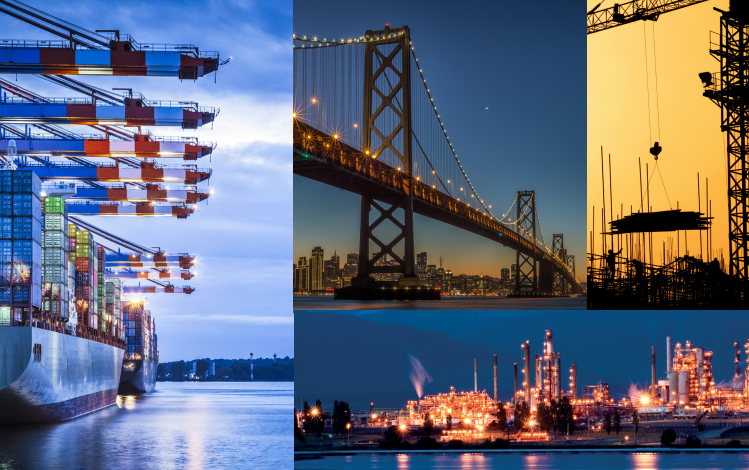The pace of monumental-scale infrastructure construction projects is on the rise worldwide, with current annual global infrastructure demand pegged at $4 trillion, according to the World Economic Forum.1 Occurring in both developed and emerging markets, these megaprojects have become multinational undertakings whose success often hinges on numerous companies and governments operating in concert, frequently in the face of political, legal, and cultural divides among the participants.
These challenges pose risks. But because the need (to build new or replace rapidly aging infrastructure) and the upside (in terms of potential profitability and benefits) are substantial, “it is imperative,” says Brookings Institute Vice President Bruce Katz, “that more U.S. metros and firms (particularly middle-market firms) expand their presence abroad.”2
According to Katz, more than 83 percent of global gross domestic product (GDP) is expected to be generated outside the U.S. over the next five years. Because so much of GDP rides on the quality and availability of robust infrastructure (road, freight rail, seaports, air hubs, etc.) so that companies can create and deliver products and services when and where they are needed, this trend portends opportunities for the global construction industry in terms of refurbishing old, and building new, infrastructure.
Who will benefit most? According to author Dan McNichol, the advantage in the global market will principally lie with “firms with the keenest understanding of the local market in which they operate…[because] risks on the legal, compliance and tax fronts are traps that ensnare the most sophisticated contractors.”3 In projects of the scale being discussed, multinational companies may well find themselves facing litigation (or the risk of litigation) challenges across multiple jurisdictions.

Impact of Urbanization and Aging Infrastructure
A sizable percentage of current and projected infrastructure spending is being driven by rapid urbanization occurring in many areas, particularly emerging markets. One expert projects that by 2050, there will be 2 billion more people living in cities worldwide than there are today.4 This kind of growth puts heavy stress on existing infrastructure and paves the way for the construction of all types of supporting infrastructure—public transportation systems, sewage systems, etc.
Decaying infrastructure is also a major driver of megaproject spending. In the United States alone, the McKinsey Global Institute estimates that annual infrastructure spending will need to increase to $150 billion more than current levels between now and 2020 to meet the country’s needs.5
San Francisco-Oakland Bay Bridge
One recent example of the kind of global, mega-infrastructure project currently underway in many locations around the world was the replacement of the San Francisco-Oakland Bay Bridge. The Bay Bridge, which originally opened to traffic on Nov. 12, 1936, was damaged by an earthquake in 1989 and needed to be rebuilt.
The $7 billion project involved a level of multinational cooperation seldom seen before. Fabrication of the main structural steel for the bridge was outsourced to China. South Korea handled the manufacturing of seismic bearings and temporary detour structures. Japan forged the world’s first double-cable saddle, which sits atop a 525-foot tower built by the Chinese. England produced the main cables’ bands. And the United States handled about 80 percent of the manufacturing.
Given how difficult it would be to correct problems later, once the various pieces of the bridge had been manufactured and shipped from such far-flung parts of the globe, production mistakes were not an option.
As Ken Terpstra, overall project manager for the California Highway Department, explained: “We sent more than 60 experts from our staff to Shanghai in an unprecedented program, in order to oversee our contractor’s work on the main structural steel fabrication. […] We had to ensure that the metals, welds and fabrication were delivered to our exacting standards here in California…[because] correcting problems on this side of the Pacific was not an option.”6
The rebuilding of the Bay Bridge was a success; it reopened on Sept. 2, 2013. And it’s not hard to see how important the role of risk management plays in such complex projects. Robin Johnson, AIG’s head of Broker and Client Management in Asia, notes: “[When] there is fabrication in multiple countries, if a client fails to buy the right programs, they face the chance that the risks won’t be covered, that there will be gaps in coverage. Before globalization of these megaprojects, that simply wasn’t the case.”7
As long as sufficient financing and industry bandwidth can be found, the globalization of mega-infrastructure projects will likely continue. Managing the projects themselves, and the risks associated with them, will remain a complex but rewarding endeavor—with the potential to deliver not only solid profits to the construction firms and investors involved, but also renewed vigor to the citizens and economies that these projects ultimately serve.
1- “Strategic Infrastructure: Steps to Prepare and Accelerate Public-Private Partnerships,” published by World Economic Forum and Boston Consulting Group, May 2013, p. 3.
2- Bruce Katz, in the p. 2 “Forward” to “Construction Goes Global: Infrastructure and Project Delivery across Borders,” an AIG white paper.
3- Dan McNichol, “Construction Goes Global,” op. cit., p. 5. McNichol is also the author of The Roads That Built America: The Incredible Story of the U.S. Interstate System. Sterling (2006).
4- Bruno Lafont, Chairman and CEO of Lafarge. Ibid., p. 6.
5- Ibid., p. 3.
6- Ibid., p. 8.
7- Ibid., p. 7
Don’t settle for half the story.
Get paywall-free access to technology news for the here and now.